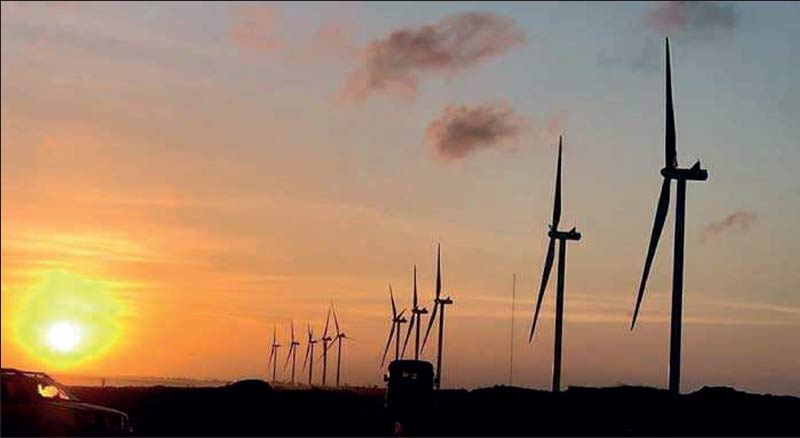Wednesday Nov 19, 2025
Wednesday Nov 19, 2025
Monday, 8 July 2024 00:20 - - {{hitsCtrl.values.hits}}

Instead of protesting against an RE project, which will contribute to Sri Lanka’s much needed energy security and take us a step forward towards freedom from fossil fuels, why aren’t these protestors doing some real environmental work on the ground?
 Recently a group of environmentalists and a religious leader approached the Supreme Court against a renewable energy project to come up in the country’s north.
Recently a group of environmentalists and a religious leader approached the Supreme Court against a renewable energy project to come up in the country’s north.
Environmentalists rallying against a renewable energy project is odd. As they should be against fossil fuel-based projects and push for a quicker energy transition for Sri Lanka to achieve its goal to become carbon neutral by 2050.
They say it is in the path of migratory birds. However, the project EIA (Environmental Impact Assessment) report says otherwise. Another report by another independent environmentalist group also says it won’t. Wouldn’t it be wiser to engage in a constructive manner with all stakeholders including Government, SLSEA, the developer, and locals to resolve the issue rather than trying to stall it all at once?
Countering FDIs
Next, we turn to the recently opened bids for the 50MW wind project, as reported by the Daily FT (https://www.ft.lk/front-page/Adani-s-Mannar-deal-on-ropes/44-763551). The bids for the Mannar wind project are less than 5 US dollars cents per kWh, it’s important for the environmentalists to also advise and write to the media about how the EIA report is for these projects. This was a significant point of contention in the campaign against the Adani Mannar project. Will the migratory birds take a U turn? Or select which blade to hit and not hit, understanding its sign boards 50MW, 100MW or 500MW? …according to environmentalists.
Feasibility of quoted bids as per the media reports
Additionally, it is important to assess the feasibility whether the quoted amounts can be achieved through imported machinery and technology while providing it at such a low cost.
The importance of infrastructure development for project area is very significant, it’s interesting to see how the 50MW wind project developer will bring in these developments as the 500MW project through a 100% FDI notably brings infrastructure development the project to the north-western areas of the country, including employment opportunities, community development and expertise of an operation that is solely in the area of energy.
50MW vs. 500MW capacity
Comparing a 50MW project to a 500MW project highlights a disparity. It is like comparing an egg and a chicken. Is 50MW sufficient to achieve the country’s 1,200MW requirement? What are the implications and costs of relying on coal and oil for that period are considerations and basic maths would teach us apart from the climate emergency detriments it brings in.
The 50MW bid is restricted to Sri Lanka, excluding international bidders. The CEB’s publicly available Environmental Impact Assessment (EIA) specifies turbines should be 4.5MW, yet the tender is tailored for 4MW turbines. This discrepancy could affect the project’s feasibility, efficiency, and compliance with the initial EIA, potentially violating bid requirements. The difference in turbine specifications (4.5MW vs. 4MW) will affect the overall efficiency and feasibility of the project. Using turbines that do not meet the EIA specifications result in suboptimal performance and lower energy output, impacting the project’s success.
Domestic bidding restrictions
The 50MW bid is restricted to Sri Lanka, excluding international bidders. The CEB’s publicly available Environmental Impact Assessment (EIA) specifies turbines should be 4.5MW, yet the tender is tailored for 4MW turbines. This discrepancy could affect the project’s feasibility, efficiency, and compliance with the initial EIA, potentially violating bid requirements, raising concerns about adherence to regulatory standards and environmental guidelines.
The Ceylon Electricity Board was reportedly compelled to open the ‘second envelopes’ of international competitive bids for the 50MW wind power plant in Mannar on 26 June. Bids, under the ‘two-envelope’ system, closed on 9 May. There are concerns about the accuracy of claiming this as an international project. Because it is not targeting international bids. So the question of the hurry of opening bids occurs.
Instead of protesting against an RE project, which will contribute to Sri Lanka’s much needed energy security and take us a step forward towards freedom from fossil fuels, why aren’t these protestors doing some real environmental work on the ground? Given their influence, they can surely bring Renewable Energy projects in the country. Why aren’t they doing so? Or are they more interested in selectively stopping certain projects? Slogans need to be Greta Thunberg material. Sri Lanka is the only country, which is trying too hard to chase away investment, infrastructure development, savings on fossil coal, and oil forex over investment projects, and livelihood development, etc.
Economic stability the need of the hour
Over the last few years, Sri Lanka has been under heavy economic stress, exacerbated by factors like political instability, corruption, and economic mismanagement. The recent economic crisis, marked by shortages of essential goods, skyrocketing inflation, and a plummeting currency, has plunged a majority of the population into unprecedented hardship. We are still not out of the woods. Our economy shrank by 7.3% in 2022 and 2.3% in 2023 and this year we are expected to reverse the fall and grow at a mere 1.9%. Which means, economically, we are where we were 5-7 years back.
The proposed wind project by Adani promises to pump in a billion dollars as FDI in our economy at a time when we are clearly in need of it more. It will also show investor confidence in our market and can potentially attract more FDI into the country. The project is expected to create over 1,200 jobs in a region which is currently under-developed as per news reports. It will displace over $ 270 million worth of fossil fuels and cut 1.06 million tons of CO2 emission per year. Thanks to lower tariffs, Government’s electricity purchase costs will also reduce by about $ 83 million per year (about Rs. 25 billion) – corresponding to reduction in electricity tariffs of consumers by Rs. 17 per unit.
This will be a welcome respite for the common man, who has been reeling under inflationary pressures, with the cost of staple foods like rice, vegetables, and fish increasing dramatically over the last 2-3 years. Fuel, healthcare, education, all have become more expensive. This has had a devastating impact on the average Sri Lankan and household budgets have been stretched thin, with many families struggling to afford basic necessities.
If the opposition is that concerned about the environment and cost, then why are they not displaying similar outrage for other renewable energy projects? If power cost is a concern, then why silence on projects which have been approved at a higher tariff? Policymakers and citizens need to look at the larger picture and set a clear roadmap to achieve the national goal of energy self-sufficiency and take all actions keeping this core objective in mind. They should seriously question if anybody else has an appetite for implementing such large scale RE projects; why aren’t they doing so, instead of delaying the existing projects?
Indeed, the whole of citizens’ human rights are on the ropes to experience what is supposed to be a greener and an investment-friendly future.
(The writer is an engineer specialising in renewable energy engineering. With a robust background in the mechanical and power and energy sector, he has dedicated his career to pioneering sustainable energy solutions spanning over 40 years across UAE, Saudi Arabia, Sri Lanka and Australia. He can be reached at [email protected].)